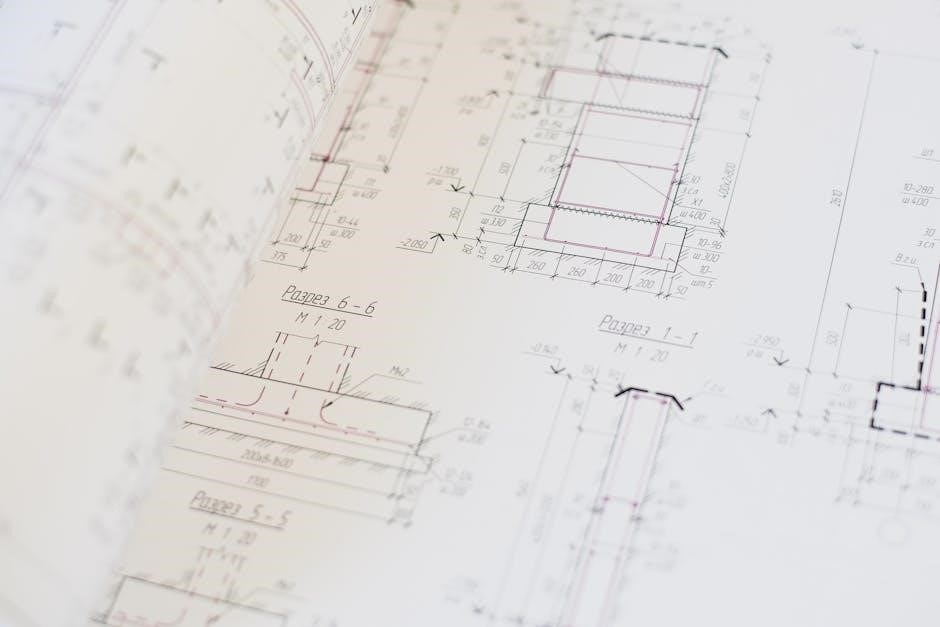Qualification Description
The Advanced Diploma of Civil Construction Design prepares individuals for roles as senior civil works designers or para-professional designers supporting professional engineers. It involves complex‚ technical tasks and strategic activities‚ requiring the application of theoretical and technical knowledge to design intricate projects that meet client and site requirements.
1.1 Overview of the Advanced Diploma of Civil Construction Design
The Advanced Diploma of Civil Construction Design is a qualification designed for individuals seeking to enhance their expertise in civil construction design. It focuses on advanced technical tasks‚ strategic activities‚ and the application of theoretical knowledge to solve complex problems. The program covers specialized areas such as civil steel structures‚ site requirements‚ and project implementation. Students learn to design intricate projects‚ ensuring compliance with client specifications and industry standards. This qualification prepares learners for roles as senior designers or para-professionals supporting engineers‚ emphasizing self-directed learning and practical skill development.

1.2 Target Audience and Career Opportunities
The Advanced Diploma of Civil Construction Design is ideal for individuals seeking to advance their careers in civil construction or enter the field as senior designers or para-professionals. It caters to those aspiring to support professional engineers in complex projects. Graduates can pursue roles in infrastructure development‚ urban planning‚ and construction management. The qualification also serves as a pathway to higher education‚ such as graduate diplomas or degrees in civil engineering. It equips learners with specialized skills‚ making them competitive in sectors like transportation‚ infrastructure‚ and urban development.
1.3 Key Responsibilities and Roles
Graduates of the Advanced Diploma of Civil Construction Design are tasked with designing complex infrastructure projects‚ managing technical construction aspects‚ and collaborating with engineers. They ensure projects meet safety‚ regulatory‚ and client requirements. Responsibilities include strategic planning and problem-solving‚ initiating activities to support project success. This role demands technical expertise and strategic thinking to handle intricate designs and manage project demands effectively‚ ensuring all deliverables align with industry standards.

Assessment Requirements
The Advanced Diploma of Civil Construction Design requires students to complete challenge tests and skill demonstrations in real or simulated environments to meet competency standards.
2.1 Types of Assessments and Their Objectives

The assessments for the Advanced Diploma of Civil Construction Design include challenge tests‚ skill demonstrations‚ and evidence-based evaluations. These assessments aim to verify a student’s ability to apply theoretical knowledge in practical scenarios‚ ensuring they meet industry standards. Challenge tests evaluate problem-solving skills and technical expertise‚ while skill demonstrations assess hands-on capabilities in real or simulated workplace environments. Evidence requirements include detailed assignments‚ reports‚ and site documentation‚ ensuring comprehensive understanding and competence in complex project design and management.
2.2 Challenge Tests and Skill Demonstrations
Challenge tests and skill demonstrations are critical components of the assessment process for the Advanced Diploma of Civil Construction Design. These assessments evaluate a student’s ability to apply theoretical knowledge in practical‚ real-world scenarios. Challenge tests focus on problem-solving and technical expertise‚ while skill demonstrations assess hands-on proficiency in tasks such as designing complex projects or interpreting site requirements. These assessments are typically conducted in simulated or real workplace environments‚ ensuring students can perform tasks safely and effectively. The outcomes are used to validate competence and readiness for industry roles.
2.3 Evidence Requirements for Competency
Evidence requirements for competency in the Advanced Diploma of Civil Construction Design include detailed assignments‚ reports‚ and practical demonstrations. Students must provide evidence of their ability to apply theoretical knowledge to real-world scenarios‚ such as designing complex civil projects. Evidence must include calculations‚ Bills of Quantities (BoQ)‚ and site photos‚ showcasing their problem-solving skills and technical expertise. Assessments must be authentic‚ valid‚ and reliable‚ ensuring students meet industry standards. This evidence is rigorously reviewed by assessors to confirm competency and readiness for professional roles in civil construction design.

Units of Competency
The Advanced Diploma of Civil Construction Design consists of 12 units of competency‚ including 5 core and 7 elective units. These units cover advanced design principles‚ project management‚ and technical skills. Core units focus on essential competencies‚ while electives allow specialization in areas like structural design or site planning. Each unit is designed to align with industry requirements‚ ensuring students develop practical skills and theoretical knowledge. Completion of all units is mandatory for certification‚ enabling graduates to meet the demands of senior roles in civil construction design and related fields.
3.1 Core Units Overview
The core units of the Advanced Diploma of Civil Construction Design are essential for developing foundational skills in civil design. These units focus on areas such as design principles‚ project management‚ and technical knowledge. They emphasize the application of engineering principles‚ risk management‚ and environmental considerations. Core units also cover the preparation of detailed designs and the use of civil construction software. These units are mandatory and provide the necessary competencies to meet industry standards. They are assessed through practical demonstrations‚ challenge tests‚ and detailed project work‚ ensuring students can apply their skills in real-world scenarios. This ensures graduates are job-ready and meet the expectations of employers in the civil construction sector.
3.2 Elective Units and Their Specialization
The elective units in the Advanced Diploma of Civil Construction Design allow students to specialize in specific areas of civil construction. These units focus on advanced topics such as structural analysis‚ geotechnical design‚ and project coordination. Electives provide students with the flexibility to tailor their skills to industry demands or personal career goals. They cover specialized tasks like designing concrete structures‚ managing civil works‚ and applying surveying techniques. These units enhance technical expertise and prepare graduates for diverse roles in the construction industry‚ ensuring they can adapt to various project requirements and industry sectors.

3.3 Total Units and Completion Requirements
The Advanced Diploma of Civil Construction Design requires completing a total of 12 units of competency‚ consisting of 5 core units and 7 elective units. To achieve the qualification‚ students must demonstrate competency in all units through assessments‚ which include practical tasks‚ projects‚ and theoretical exercises. Successful completion requires meeting the specified performance criteria for each unit‚ showcasing both technical skills and knowledge. Recognition of prior learning may also contribute to completing the qualification‚ ensuring learners can apply their existing expertise toward the course requirements.
Career Pathways and Progression
Graduates can transition to higher education‚ such as graduate diplomas or bachelor’s degrees in civil construction. The qualification also opens pathways to roles in infrastructure‚ transportation‚ and urban development sectors‚ enabling professional advancement and specialized career growth.
4.1 Transition to Graduate Diplomas and Higher Education
Graduates of the Advanced Diploma of Civil Construction Design are well-prepared to transition into graduate diplomas and higher education qualifications. Many institutions recognize this diploma as a pathway to further studies‚ such as bachelor’s degrees in civil engineering or construction management. This qualification demonstrates a strong foundation in technical and theoretical knowledge‚ making students competitive for advanced academic programs. Successful completion of the diploma also aligns with the entry requirements for graduate-level studies‚ enabling learners to pursue specialized roles and enhance their career prospects in the civil construction industry.
4.2 Industry Sectors and Employment Opportunities
The Advanced Diploma of Civil Construction Design equips graduates for diverse roles across various industry sectors‚ including infrastructure‚ transportation‚ and urban development. Employment opportunities exist in both public and private sectors‚ with roles such as civil engineering design draftspersons‚ project managers‚ and construction estimators. Graduates are also suited for positions in consulting firms‚ government agencies‚ and contracting organizations. The qualification prepares learners for specialized roles requiring technical expertise‚ making them highly competitive in the job market. This diploma opens pathways to careers that involve designing‚ managing‚ and delivering complex civil construction projects effectively.
4.3 Professional Development and Advancement
The Advanced Diploma of Civil Construction Design fosters continuous learning and professional growth‚ enabling graduates to pursue specialized roles and advanced certifications. It provides a pathway to higher education‚ such as graduate diplomas or degrees in civil engineering‚ enhancing career prospects. Professionals can also obtain memberships in industry bodies‚ like Engineers Australia‚ to expand their networks and credentials. Additionally‚ the qualification supports skill development in emerging technologies and sustainable practices‚ ensuring graduates remain competitive in a rapidly evolving industry. This diploma is a stepping stone for advancing into leadership roles or starting specialized consultancies.

Resource Requirements
Students require a laptop with Office 365 or similar software‚ specialized design tools‚ and internet access. Institutional specifications ensure access to necessary software and technologies for coursework.
5.1 Essential Tools and Software for Students
Students enrolling in the Advanced Diploma of Civil Construction Design require a laptop with Office 365 or equivalent software. Specialized design tools like CAD‚ Revit‚ and AutoCAD are essential for creating detailed project designs. Internet access is mandatory for accessing cloud-based platforms and institutional resources. Students must ensure their devices meet the minimum specifications outlined by the institution to run required software effectively. Additional tools may include spreadsheet software for calculations and project management applications for task organization. Adherence to institutional specifications ensures compatibility and seamless learning.
5.2 Institutional Specifications and Recommendations
Institutions delivering the Advanced Diploma of Civil Construction Design specify that students must have access to a laptop with a modern processor‚ at least 8GB RAM‚ and 512GB storage. Software requirements include AutoCAD‚ Revit‚ and CAD tools for design tasks. A reliable internet connection is essential for accessing cloud-based platforms and institutional resources. Students are recommended to use a graphics card for enhanced performance. Institutions may also require antivirus software and endpoint protection for secure access to their systems. Adhering to these specifications ensures students can fully engage with course materials and complete assessments effectively.
5.3 Access to Simulated or Real Workplace Environments
Access to simulated or real workplace environments is crucial for students pursuing the Advanced Diploma of Civil Construction Design. Institutions often provide virtual simulations or partnerships with construction sites to enable practical learning. These environments allow students to apply theoretical knowledge to real-world scenarios‚ such as conducting site surveys‚ analyzing soil conditions‚ and designing structural components. Hands-on experience in these settings ensures students develop industry-specific skills‚ preparing them for challenges in civil construction. Simulated environments also offer a safe space for experimentation and innovation‚ aligning with the course’s focus on complex project design and problem-solving.

Skills Assessment for Migration
For migration‚ an AQF Diploma or higher in a relevant field and at least one year of work experience are required. Engineers Australia conducts the assessment process.
6.1 AQF Diploma or Higher Requirements
For migration purposes‚ applicants must hold an AQF Diploma or higher qualification in a field relevant to their nominated occupation. This ensures the qualification aligns with Australian standards. The Advanced Diploma of Civil Construction Design is recognized as meeting this requirement‚ provided it is accompanied by at least one year of relevant work experience. Engineers Australia assesses these qualifications to confirm their comparability to the AQF framework. The qualification must demonstrate technical knowledge and skills directly applicable to the civil construction industry. This requirement is critical for obtaining a positive skills assessment outcome for visa applications.
6.2 Work Experience and Qualification Relevance
A positive skills assessment requires both a relevant qualification and work experience. The Advanced Diploma of Civil Construction Design must align with the nominated occupation‚ demonstrating technical expertise in civil design. Applicants need at least one year of post-qualification work experience in a relevant field. This experience must involve tasks such as designing civil structures‚ managing projects‚ or applying engineering principles. The work experience should reflect the practical application of skills gained through the qualification. Engineers Australia evaluates both the qualification and work experience to ensure they meet the standards for migration skills assessment outcomes.
6.3 Engineers Australia Assessment Process
Engineers Australia conducts a detailed assessment of qualifications and work experience for migration purposes. Applicants with an Advanced Diploma of Civil Construction Design must demonstrate that their qualification aligns with the Australian Qualifications Framework (AQF) Diploma level or higher. Engineers Australia evaluates the relevance of the qualification to the nominated occupation and assesses the underpinning knowledge and practical skills. A positive assessment outcome is essential for visa applications. The process involves verifying academic credentials and work experience‚ ensuring they meet the competency standards for engineering occupations in Australia. This assessment is critical for skilled migration pathways.

Entry Requirements
Entry requires meeting academic and language standards‚ with an IELTS score of at least 6.0. Prior learning and experience may be recognized‚ easing enrollment processes.
7.1 Academic and Language Proficiency Standards
Prospective students must meet specific academic and language requirements. Academic standards typically include the completion of a relevant AQF Certificate IV or equivalent. Language proficiency is assessed through IELTS‚ with a minimum score of 6.0 overall‚ no band below 5.5; Alternative English tests‚ such as PTE or TOEFL‚ may also be accepted‚ provided they meet equivalent standards. These requirements ensure students have the necessary skills to engage effectively with the course content and achieve the learning outcomes.
7.2 Prior Learning and Experience Recognition
Prior learning and experience can be recognized through formal assessment processes. Students with relevant qualifications or work experience in civil construction may apply for Recognition of Prior Learning (RPL). This allows them to gain credits for units they have already completed or demonstrated competency in. Documentation such as certificates‚ transcripts‚ or work portfolios may be required to support the application. RPL can significantly reduce the number of units needed to complete the qualification‚ making the program more efficient for those with existing knowledge and skills.
7.4 Specific Prerequisites for Enrollment
Enrollment in the Advanced Diploma of Civil Construction Design requires specific prerequisites to ensure students are adequately prepared. Applicants must hold a relevant qualification‚ such as a diploma in engineering or a related field‚ or demonstrate equivalent work experience. Academic proficiency in English is mandatory‚ with minimum IELTS scores of 6.0 or equivalent. Additionally‚ students may need to provide evidence of relevant work experience in the civil construction industry. These prerequisites ensure that students possess the foundational knowledge and skills necessary to succeed in the program.
Course Structure and Delivery
The course offers flexible scheduling with a duration tailored to skill development. A Training and Assessment Strategy (TAS) guides delivery‚ incorporating simulated and real workplace environments for practical application.

8.1 Duration and Scheduling Flexibility
The Advanced Diploma of Civil Construction Design typically spans 12-18 months‚ depending on delivery mode. Flexible scheduling allows students to balance study with other commitments‚ with options for full-time or part-time enrollment. Institutions may offer modular delivery‚ enabling students to progress at their own pace. The duration is designed to ensure ample time for skill development‚ practical application‚ and assessment preparation. Scheduling flexibility accommodates diverse learning needs‚ including simulated workplace training and real-world project applications‚ ensuring comprehensive preparation for industry demands.
8.2 Training and Assessment Strategy (TAS)
The Training and Assessment Strategy (TAS) for the Advanced Diploma of Civil Construction Design outlines structured delivery methods‚ ensuring alignment with industry standards. It integrates both theoretical and practical training‚ with assessments designed to evaluate competency in tasks such as designing complex civil projects and applying technical knowledge. The TAS emphasizes the use of simulated work environments to mirror real-world scenarios‚ allowing students to practice and demonstrate skills effectively. Regular updates to the TAS ensure it remains current with industry advancements and educational requirements‚ providing a robust framework for student success and preparedness for professional roles.
8;3 Continuous Improvement and Updates
The Training and Assessment Strategy (TAS) for the Advanced Diploma of Civil Construction Design is a living document‚ subject to continuous improvement to reflect industry advancements and educational best practices. Updates are made to ensure the curriculum remains relevant‚ addressing emerging technologies and methodologies in civil construction design. Feedback from stakeholders‚ including students‚ trainers‚ and industry professionals‚ is regularly incorporated to enhance the learning experience. These updates aim to improve assessment outcomes‚ ensure compliance with regulatory requirements‚ and maintain the qualification’s alignment with industry demands‚ ultimately benefiting both students and employers in the civil construction sector.
Licensing and Certification
Licensing and certification requirements vary across states‚ territories‚ and industry sectors. Completing the Advanced Diploma ensures compliance with regulatory standards‚ enhancing professional credibility in civil construction design.
9.1 State and Territory Variations
Licensing and certification requirements for the Advanced Diploma of Civil Construction Design vary across states and territories due to differing legislative and regulatory frameworks. While the qualification is nationally recognized‚ specific certifications or registrations may be mandated by local authorities to practice as a civil construction designer. Students are advised to consult their state or territory’s regulatory bodies to understand region-specific compliance requirements. This ensures adherence to local building codes‚ environmental regulations‚ and industry standards‚ which may differ significantly between jurisdictions.
9.2 Industry-Specific Regulatory Requirements
Industry-specific regulatory requirements for the Advanced Diploma of Civil Construction Design vary depending on the sector‚ such as road‚ rail‚ or water infrastructure. Each sector may have unique compliance standards‚ safety protocols‚ and environmental regulations. For example‚ projects involving major infrastructure must adhere to stringent technical specifications and quality assurance processes. Additionally‚ certifications from professional bodies like Engineers Australia may be required for certain roles. These requirements ensure graduates meet industry standards and are prepared for sector-specific challenges‚ making them more competitive in specialized fields within civil construction. Compliance with these regulations is critical for both certification and employment.
9.3 Certification Benefits and Compliance
Certification in the Advanced Diploma of Civil Construction Design ensures compliance with industry standards and enhances career prospects. Meeting the AQF Diploma requirements verifies a graduate’s expertise in civil design‚ making them eligible for professional certifications. Certification benefits include enhanced credibility‚ access to senior roles‚ and recognition by regulatory bodies. Compliance with certification standards ensures adherence to safety‚ environmental‚ and quality regulations. It also facilitates continuous professional development‚ aligning with industry advancements. Certification is crucial for maintaining employability and advancing in the civil construction sector‚ where accredited qualifications are often mandated for project leadership roles.
Credit Transfer and Recognition
Credit transfer is available for eligible students based on prior learning or experience. Recognition of prior learning (RPL) and completed units reduces the course duration and requirements‚ streamlining the qualification process.
10.1 Process and Eligibility Criteria
The credit transfer process involves assessing prior qualifications or experience relevant to the Advanced Diploma of Civil Construction Design. Eligibility is determined by matching completed units or equivalent competencies from recognized institutions or professional certifications. Students must provide detailed transcripts‚ certificates‚ or portfolios as evidence. Recognition of prior learning (RPL) is also considered‚ allowing individuals to demonstrate skills acquired through work experience. The process streamlines the qualification journey‚ reducing the number of units needed for completion. Eligibility criteria ensure that transferred credits align with the course’s learning outcomes‚ maintaining academic integrity and relevance to the construction design field.
10.2 Units and Qualifications Considered
For credit transfer‚ units completed in prior qualifications are assessed for alignment with the Advanced Diploma of Civil Construction Design. Both core and elective units are considered if they match the competency requirements of the current course. Qualifications from recognized institutions‚ such as diplomas or certificates in civil construction or related fields‚ are eligible for credit. Relevant work experience and recognition of prior learning (RPL) are also evaluated for equivalency. Transcripts‚ certificates‚ and detailed unit outlines must be provided as evidence. Units must align with the course’s learning outcomes to be considered for transfer.
10.3 Authorization and Documentation Needs
Students seeking credit transfer must provide authorization for the institution to access their prior academic records. Documentation requirements include certified copies of certificates‚ transcripts‚ and detailed unit outlines from previous qualifications. These documents must clearly outline the units completed‚ their content‚ and the institution’s accreditation. Verification of authenticity may be required. Recognition of prior learning (RPL) applications must include evidence of relevant work experience‚ such as employment records or project documentation. All submitted documents must comply with the institution’s policies and be provided in an approved format for assessment. Accuracy and completeness of documentation are critical for a successful credit transfer evaluation.
